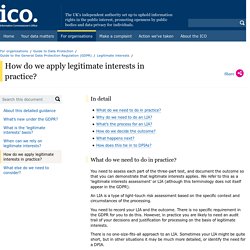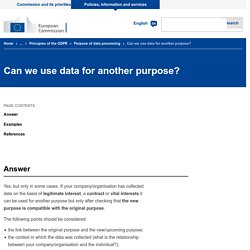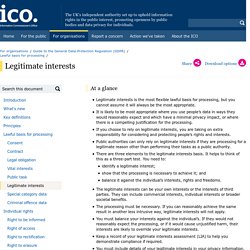

This
means that any data item that is not directly linked to obtaining, realising or otherwise accomplishing the legitimate interests pursued is not processed lawfully. Necessity implies the need for a combined, fact-based assessment of the effectiveness of processing that data for the objective pursued and of whether processing that data is less intrusive for the rights of individuals compared to other options for achieving the same goal.
2. Existence of a legitimate interest: In order to be able to process data on the basis of Article 6(1)(f) GDPR, it is essential that the purpose pursued for that processing activity is for a legitimate interest, which can pertain to the controller or even to a third party. As the Article 29 Working Party explains in its guidance, the rule refers, generally, “to (any kind of) legitimate interest pursued by the controller (in any context)”
The interest must be real and present, something that corresponds with current activities or benefits that are expected in the very near future. It must be sufficiently clearly articulated to allow a balancing test to be carried out against the interests and fundamental rights of the data subject. And it must be legitimate, in the sense that it must be lawful, permitted by
applicable EU and national law.
The Preamble of the GDPR offers some examples of legitimate interests: preventing fraud13, direct marketing14, transmitting personal data within
a group of undertakings for internal administrative purposes including the processing of clients’ or employees’ personal data15, ensuring network and information security, including preventing unauthorised access to electronic communications networks and malicious code distribution and stopping ‘denial of service’ attacks and damage to computer and electronic
communication systems16. Regardless of these examples, it should once again be emphasised that any kind of legitimate interest pursued by the controller in any context can be taken into account for legitimising a processing activity under Article 6(1)(f). However, the other two conditions must also be met for the processing to be lawful under this ground:
necessity, detailed above, and the balancing exercise, detailed below.
3. Balancing exercise: Finally, the mere existence of a real and present, sufficiently articulated legitimate interest is not enough for the processing to be considered lawful under Article 6(1)(f) GDPR. The last element that needs to be complied with is a balancing test between those interests and the interests or fundamental rights and freedoms of the individuals whose data are processed. More weight is added to the latter if the data subject is a child.
Morrison Vicarious liability - Copy. Chesteru3a legitimateinterestassessment. 20180618 LIA recommendations. 20180618 LIA strategy planning. 20180618 LIA call recording. Legitimate interest assessment. Opinion22017ondataprocessingatwork-wp249. DD CCTV Legitimate Interests Assessment v0 2. DPN-Guidance-A4-Publication. Gdpr-guidance-legitimate-interests-sample-lia-template. How do we apply legitimate interests in practice? In detail What do we need to do in practice?

You need to assess each part of the three-part test, and document the outcome so that you can demonstrate that legitimate interests applies. We refer to this as a ‘legitimate interests assessment’ or LIA (although this terminology does not itself appear in the GDPR). An LIA is a type of light-touch risk assessment based on the specific context and circumstances of the processing. You need to record your LIA and the outcome. There is no one-size-fits-all approach to an LIA. Why do we need to do an LIA? There is no obligation in the GDPR to do an LIA, but it is best practice to conduct one and it is difficult to meet your obligations under the accountability principle without it. The LIA encourages you to ask yourself the right questions about your processing and objectively consider what the reasonable expectations of the individuals are and any impact of the processing on them.
Conducting an LIA helps you ensure that your processing is lawful. 1. Full house at IAPP Brussels interested in Deciphering Legitimate Interests. Download our LI Report here! Can we use data for another purpose? Answer Yes, but only in some cases.

If your company/organisation has collected data on the basis of legitimate interest, a contract or vital interests it can be used for another purpose but only after checking that the new purpose is compatible with the original purpose. Consent-and-legitimate-interest_5ae1fbf5c6066. 2018 Legitimate Interests under GPPR Webinar May 9. Legitimate interests. At a glance Legitimate interests is the most flexible lawful basis for processing, but you cannot assume it will always be the most appropriate.It is likely to be most appropriate where you use people’s data in ways they would reasonably expect and which have a minimal privacy impact, or where there is a compelling justification for the processing.If you choose to rely on legitimate interests, you are taking on extra responsibility for considering and protecting people’s rights and interests.Public authorities can only rely on legitimate interests if they are processing for a legitimate reason other than performing their tasks as a public authority.There are three elements to the legitimate interests basis.

It helps to think of this as a three-part test. Checklists. Legitimate-Interests-and-Integrated-Risk-and-Benefits-Assessment. Legitimate Interest – GDPR EU.org. Deciphering_Legitimate_Interests_Under_the_GDPR. LIA iFriend.